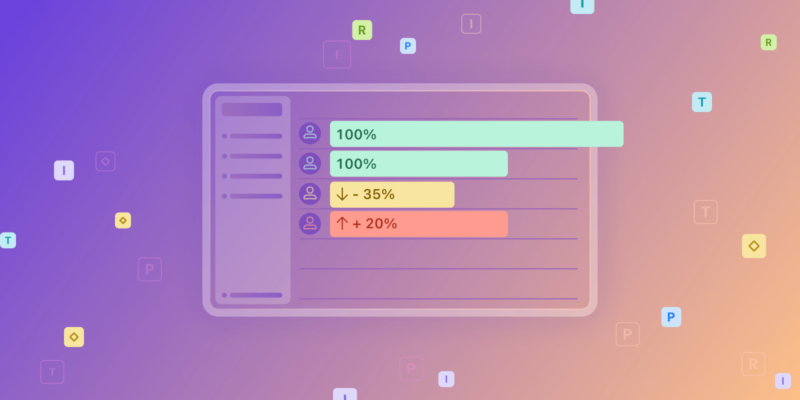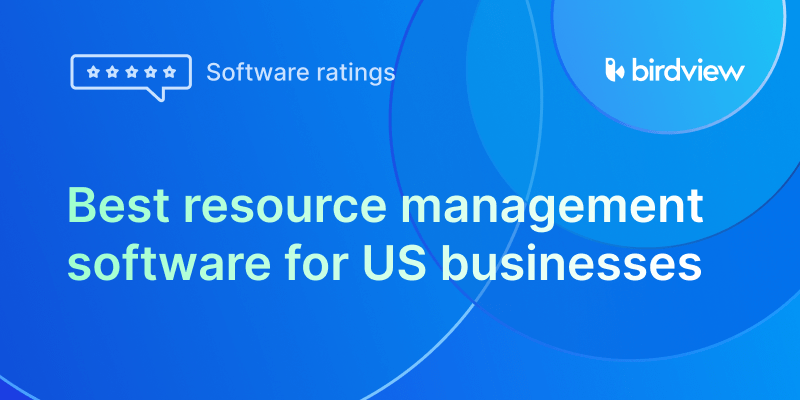Have you ever been caught in a project where tasks slip through the cracks or team members aren‘t clear on who‘s in charge? This is a common hurdle in project management, but it doesn‘t have to be. The Responsibility Assignment Matrix (RAM) is a game-changing tool that brings order to the chaos. RAM ensures that everyone knows their role and projects run smoothly by clearly defining who is responsible for each task, who makes the final call, and who needs to be kept in the loop. In this article, we‘ll see how RAM can help you overcome confusion, improve team collaboration, and keep your projects on track from start to finish.
What is a Responsibility Assignment Matrix (RAM) in project management?
A Responsibility Assignment Matrix (RAM), also sometimes referred to as a resource assignment matrix, is a project and resource management tool that helps you define the roles and responsibilities of your team members for each task or deliverable within a project. Also known as a RACI Matrix (where RACI stands for Responsible, Accountable, Consulted, and Informed), the RAM is a simple grid that maps tasks on one axis and team members or roles on the other. By filling in the matrix, you clarify who is responsible for executing tasks, who is accountable for ensuring they are completed, who needs to be consulted before decisions are made, and who should be kept informed throughout the process.
Types of Responsibility Assignment Matrix (RAM)
This structured approach is invaluable in complex projects, where clear communication and understanding of roles are essential to avoid bottlenecks, overlapping responsibilities, and missed deadlines.
The Responsibility Assignment Matrix (RAM) comes in several variations, each designed to fit different project needs and organizational structures. While the core purpose remains the same–defining and assigning responsibilities–different types of RAMs allow for flexibility depending on the complexity of the project or the level of detail required. Let‘s take a look at the most common types of RAMs.
RACI Matrix:
- Responsible: The person or team responsible for completing the task.
- Accountable: The individual ultimately answerable for the task’s completion. There should only be one accountable person per task.
- Consulted: Those whose opinions are sought (subject matter experts, for example) before a task is completed.
- Informed: People who are kept up-to-date on progress, but do not need to be consulted or directly involved.
Example: A company running a new product launch campaign can use a RACI Matrix to assign roles. The marketing manager (A) is accountable for the overall success of the campaign, while the content team (R) is responsible for creating promotional materials. The legal team (C) is consulted for compliance with advertising regulations, and the CEO (I) is kept informed of key campaign milestones.
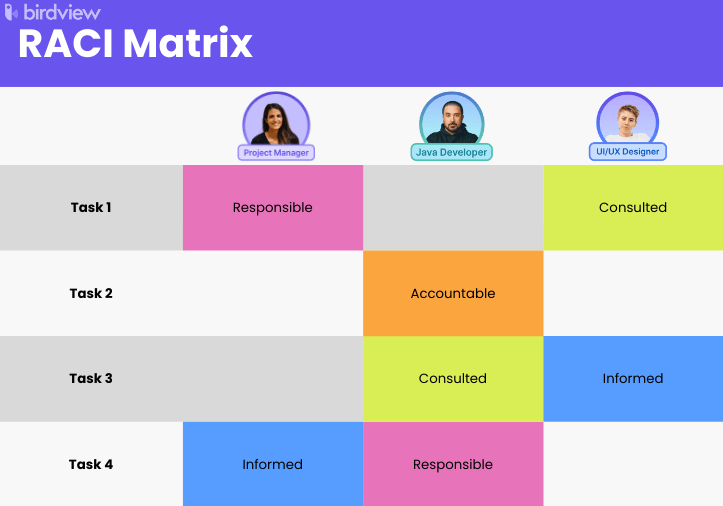
RASCI Matrix:
- Adds Support: The role that provides resources or assistance to the person responsible.
Example: In a software development project, the lead developer (A) is accountable for delivering the final product. Junior developers (R) are responsible for writing the code, while the UI/UX designers (S) support the process by providing design resources. QA testers (C) are consulted during the testing phase, and the client (I) is informed of progress.
CAIRO Matrix:
- Includes Omitted: Roles or individuals who are intentionally excluded from a particular task or decision.
Example: In a construction project, the project manager (A) is accountable for overseeing all stages. The structural engineer (R) is responsible for designing the foundation, while the architect (C) is consulted on the overall design. The electrical contractor (O) is omitted during the foundation stage but will be involved later. The local government (I) is kept informed about permits and inspections.
Responsibility Assignment Matrix benefits
Implementing a Responsibility Assignment Matrix (RAM) can make a significant impact on the way your project team operates. Whether your project involves a few individuals or multiple teams across different departments, a resource assignment matrix brings structure and clarity to task delegation, helping you avoid common pitfalls like missed deadlines, unclear responsibilities, and inefficient resource allocation. Here are some of the key benefits of using RAM in your project:
- Clarity and transparency
A RAM provides a clear understanding of who is responsible for each task, eliminating ambiguity. Everyone knows their role, which helps streamline decision-making and prevents misunderstandings about who owns a specific task.
- Improved communication
By mapping out who needs to be consulted or informed, a resource assignment matrix ensures that the right people are involved in discussions, reducing unnecessary communication and ensuring that key stakeholders stay in the loop at the right times.
- Enhanced accountability
With a designated person accountable for each task, the RAM ensures that there‘s a clear point of contact for progress updates and issue resolution. This creates a sense of ownership, helping tasks move forward without unnecessary delays.
- Efficient resource allocation
The RAM helps you allocate tasks based on team members’ roles, expertise, and availability. This prevents overallocation or misallocation of resources and helps you ensure that work is assigned to the right people.
- Reduced risk of overlap or gaps
By outlining each person‘s responsibilities, a resource assignment matrix minimizes the risk of work being duplicated or, worse, tasks being overlooked. This leads to a more efficient workflow and reduces the likelihood of last-minute surprises.
How to create a Responsibility Assignment Matrix
Creating a Responsibility Assignment Matrix is a straightforward but critical process for ensuring the success of your project. A well-constructed RAM provides a clear, visual representation of roles and responsibilities, helping your team understand who is responsible for each task, who has the final say, and who needs to be consulted or informed.
While creating a RAM may seem simple, attention to detail is crucial in ensuring that every task and role is accurately defined. Below is a step-by-step guide to creating a resource assignment matrix that will keep your project organized, on track, and aligned with its goals.
- Identify project tasks: Start by listing out all the tasks, deliverables, or milestones that need to be completed. These should be the key activities required to achieve the project‘s goals.
- Determine roles or team members: Identify the individuals or roles involved in the project. Depending on the size of the project, this might include project team members, external stakeholders, or departments.
- Assign responsibilities: Using the chosen RAM framework (e.g., RACI), assign the appropriate responsibilities for each task. Make sure there is one accountable person for each task and clarify who needs to be consulted or informed.
- Review and validate: Once the matrix is filled out, review it with the team to ensure everyone agrees with their roles and responsibilities. This step ensures that no roles are missed and that there is a clear understanding across the board.
- Update regularly: As the project evolves, so will the responsibilities. Make sure to update the RAM to reflect changes in the project scope, team composition, or responsibilities to keep it accurate and relevant.
Responsibility Assignment Matrix template
To help you get started, here‘s a simple template for a RACI Matrix. You can customize this template to fit the needs of your project.
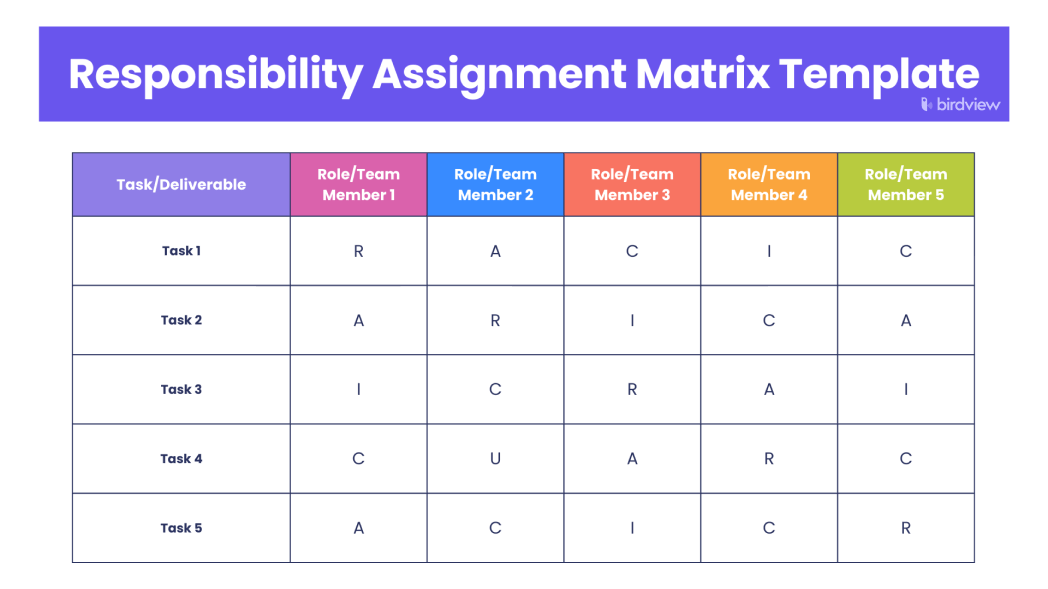
Responsibility assignment matrix example
Case study 1: How a RACI matrix was used in a software development project
In a mid-sized software development project, the team used a RACI matrix to streamline the development and deployment of a new application. The project had several critical phases, including requirements gathering, coding, testing, and deployment.
- Requirements gathering: The business analyst was responsible (R), with the project manager accountable (A). Developers were consulted (C) for technical feasibility, and the client was kept informed (I).
- Coding: Developers were responsible (R) for writing the code, with the lead developer accountable (A). The QA team was consulted (C) to ensure testability, and the project manager was informed (I) of progress.
- Testing: The QA team took responsibility (R), with the lead developer accountable (A). Developers were consulted (C) to fix issues, and the project manager and client were informed (I).
- Deployment: The DevOps team was responsible (R) for deployment, with the project manager accountable (A). The QA team was consulted (C) for post-deployment checks, and all stakeholders were informed (I).
This matrix helped the team avoid miscommunication, ensured everyone knew their role, and kept the project on track.
| Task/ Deliverable | Business Analyst | Project Manager | Developers | Lead Developer | QA Team | Client | DevOps Team |
| Requirements Gathering |
R |
A | C | – | – | I |
– |
| Coding |
– |
I | R | A | C | – |
– |
| Testing |
– |
I | C | A | R | I |
– |
| Deployment |
– |
A | – | – | C | – |
R |
Case study 2: How a RACI matrix was used in a construction project
In a small office renovation project, a RAM was used to effectively manage the coordination between the key stakeholders and ensure the project was completed on time and within budget.
- Design and Layout: The interior designer was responsible (R) for creating the office layout and design, with the project manager accountable (A) for overseeing the project. The office manager was consulted (C) to ensure the design met the company‘s functional needs, while the contractor was informed (I) about the final design plans.
- Material Procurement: The contractor was responsible (R) for procuring materials needed for the renovation, with the project manager accountable (A) for budget adherence. The interior designer was consulted (C) to ensure the materials matched the design specifications, and the office manager was informed (I) of progress.
- Construction and Execution: The contractor was responsible (R) for executing the renovation, with the project manager accountable (A) for ensuring the project stayed on schedule. The interior designer was consulted (C) during the renovation for design adjustments, and the office manager was informed (I) of the project‘s progress.
This RAM ensured that each stakeholder’s role was clearly defined, reducing the risk of miscommunication and keeping the project on track.
| Task/ Deliverable | Interior Designer | Project Manager | Contractor | Office Manager |
| Design and Layout |
R |
A | I |
C |
| Material Procurement |
C |
A | R |
I |
| Construction and Execution |
C |
A | R |
I |
How to manage resources and their responsibilities with Birdview
Using a Responsibility Assignment Matrix (RAM) is a proven method for bringing clarity, accountability, and efficiency to any project. By defining who is responsible, accountable, consulted, and informed for each task, you can avoid confusion, streamline communication, and ensure smoother project execution. Whether you’re managing a complex software development project or coordinating teams on a construction site, a resource assignment matrix can be an invaluable tool for ensuring success.
However, creating and maintaining a RAM can become challenging, especially in larger projects with many moving parts. This is where advanced project management tools like Birdview project and resource management software come into play. Birdview not only helps you to track resources, monitor task progress, and ensure that responsibilities are aligned with capacity and availability. With Birdivew, you can enhance your project planning, manage resources more effectively, and keep your team on track–all in one platform.
Birdview streamlines the process by offering a suite of advanced functionalities tailored to make resource planning and management simpler, smarter, and more efficient. With Birdview, you get:
- Real-time resource tracking
Birdview allows you to monitor resource availability and utilization in real time, ensuring that tasks are assigned to the right people based on their current workload and capacity.
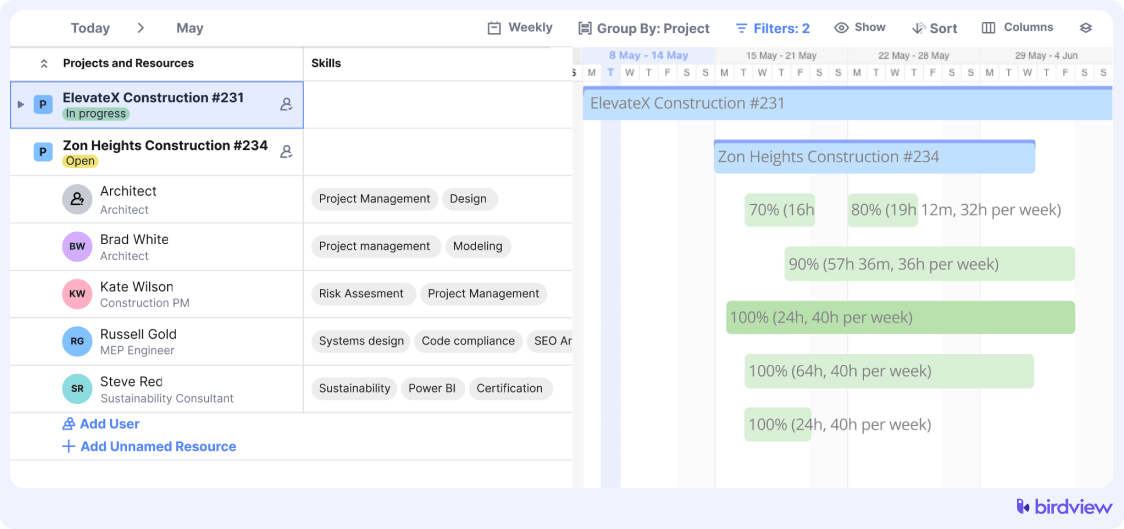
- Comprehensive project visibility
With Birdview‘s intuitive dashboards, you get a holistic view of your project progress, including who‘s working on what, task statuses, and potential bottlenecks.
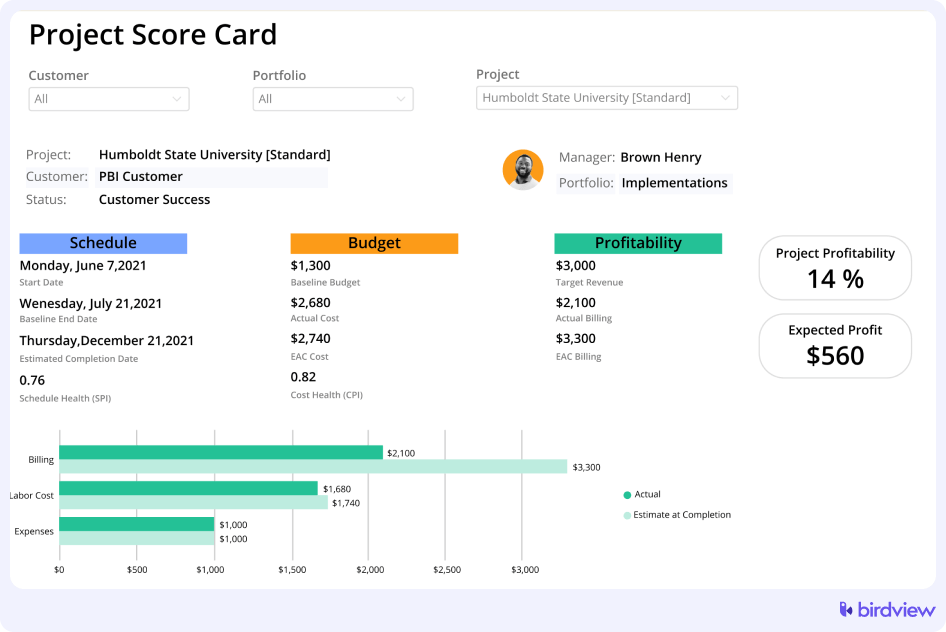
- Role-based resource allocation
Birdview helps you allocate resources based on skills, roles, and availability, ensuring the right team members are assigned to the right tasks. With its AI-powered resource suggestion feature, Birdview goes a step further by recommending the best staff options for each task, taking into account their expertise and current workload.
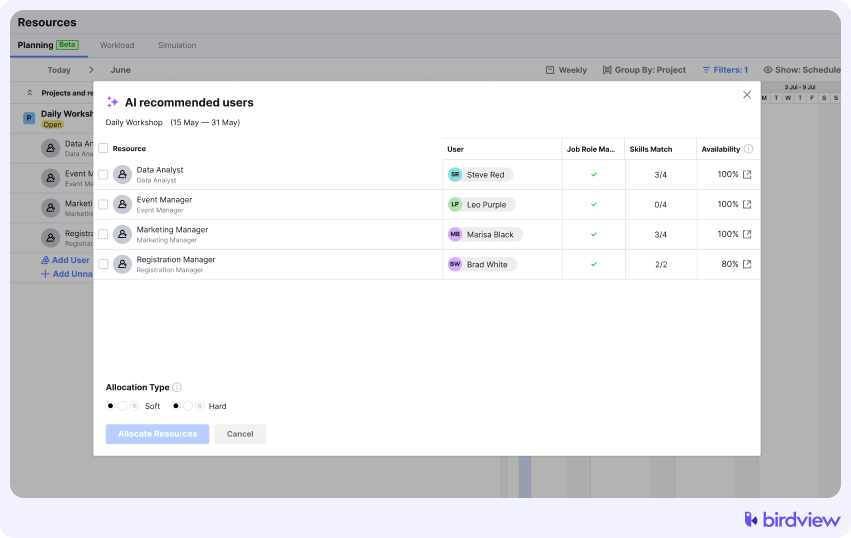
- Capacity planning
Birdview‘s capacity planning tools help you forecast resource needs and plan ahead to avoid overloading your team or underutilizing key personnel.
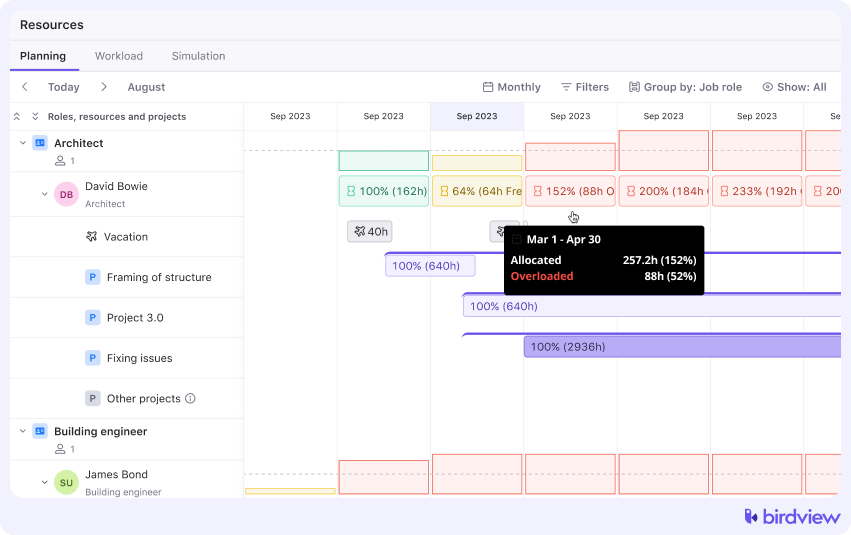
- Collaboration tools
Integrated communication features make it easy to consult and inform stakeholders, ensuring that everyone stays on the same page throughout the project lifecycle.
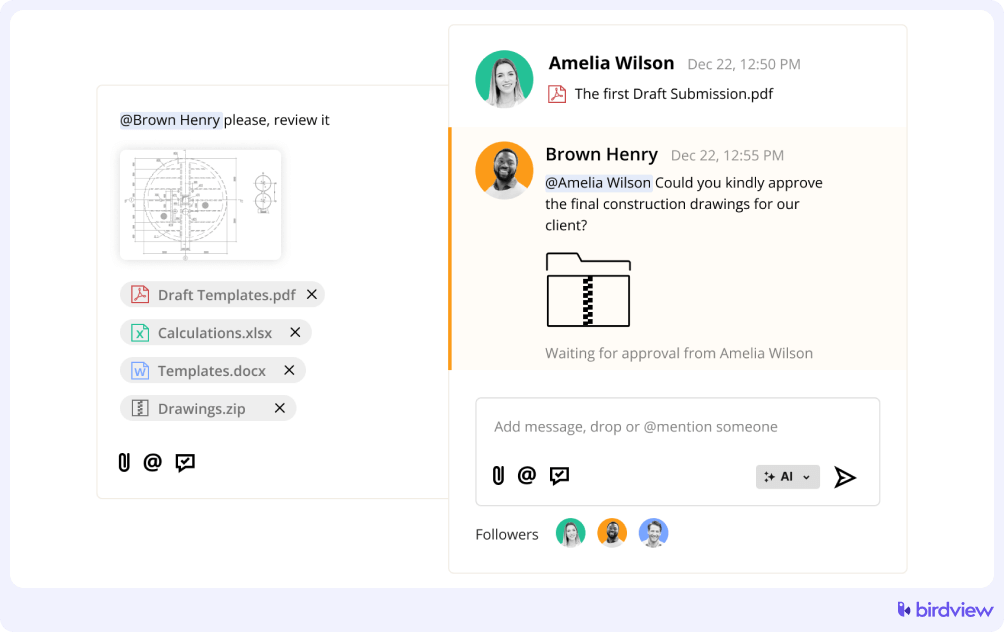
Explore how Birdview can fit your needs. Sign up for a free trial to test the platform yourself, or schedule a demo where a dedicated manager will guide you through the features and help you get the most out of the software.

